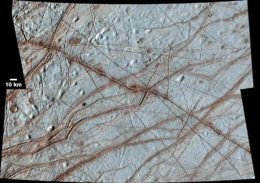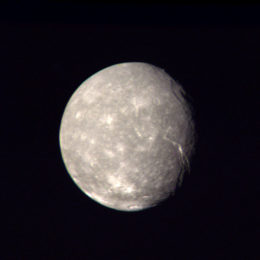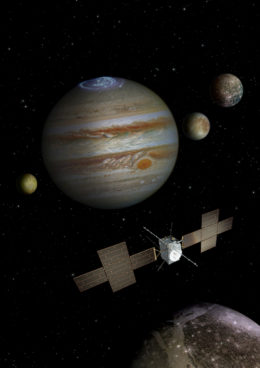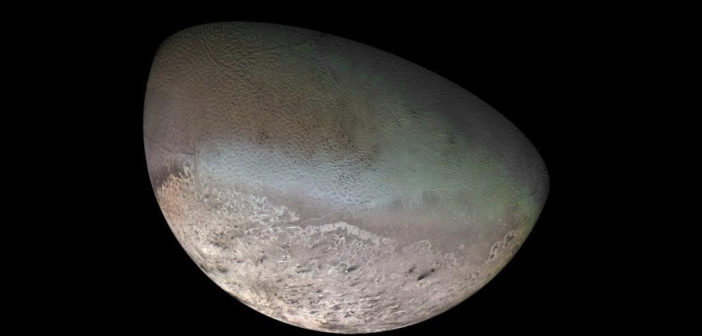Decades of observations have taught us a great deal about the planets, moons, and small bodies in our solar system. As our explorations have progressed, a new class of solar system objects has emerged: ocean worlds. In a focus issue of the Planetary Science Journal, a set of articles details proposed missions and methods to explore the icy ocean worlds in our solar system. These articles provide a potential framework for embarking on an exploration of these distant worlds, where life might develop beneath icy crusts in oceans heated by tidal forces.
Move Over, Mars!
What makes ocean worlds such intriguing targets in the search for life, as opposed to more familiar terrestrial worlds like Mars and Venus? Ocean worlds have all or most of the ingredients necessary for life as we know it: liquid water, organic material, and internal heating provided by the tidal tugs of the planets they orbit. In order of increasing distance from Earth, here are just a few of the many known and suspected ocean worlds in our solar system:
- Europa: The smallest of Jupiter’s Galilean moons has a young, smooth surface marred by a pattern of cracks called linae. These cracks may be evidence for a type of plate tectonics on Europa caused by the flexing of its ice shell.

This image from the Galileo spacecraft showcases the linae, pits, ridges, domes, and jumbled terrains called “chaos” that cover Europa’s surface. [NASA/JPL-Caltech/University of Arizona]
- Enceladus: This tiny moon of Saturn ejects plumes of water from fissures in its ice shell, broadcasting the contents of its global ocean hundreds of kilometers above its surface. The majority of the plume particles fall to the moon’s surface, where a lander mission could collect and study these particles with relative ease.
- Titan: Famous for its Earth-like surface features, substantial atmosphere, and methane rain, Saturn’s largest moon Titan is the only ocean world on which we’ve made landfall. The Huygens probe dropped to Titan’s surface in 2005, revealing in great detail what appear to be drainage channels, coastlines, and rocks made of water ice.
- Uranian satellites: During its 1986 flyby of the Uranus system, Voyager 2 glimpsed the southern hemispheres of six of Uranus’s 27 known moons. Though our explorations are now limited to ground-based telescopic observations, researchers believe that the ice giant’s five largest moons — and likely some of its smaller satellites — have or once had layers of liquid water below their surfaces. A Uranus orbiter might finally reveal the nature of the dark material mixed into these moons’ surface ice.

Titania, the largest moon of Uranus — not to be confused with Titan or Triton! — is shown here in the highest-resolution image available from Voyager 2. [NASA/JPL]
- Triton: Neptune’s largest moon is thought to be a captured Kuiper belt object, which may explain its backwards orbit. Like many of the moons in the outer solar system, the only spacecraft to visit Triton was Voyager 2 in 1989. During its visit, Voyager 2 observed Triton’s young surface, which is coated with nitrogen frost and a reddish organic material.

Though its primary target is Ganymede — the largest moon in the solar system and the only one with a global magnetic field — JUICE will also make some much-needed observations of Europa from its berth in the Jupiter system. [ESA]
Missions in the Making
The missions described in this special issue would increase our knowledge of the many icy satellites in our solar system through images, spectra, radar maps, and particle measurements of their surfaces, subsurfaces, and near-space environments. Though some of these missions are still in the planning phase, others are already ramping up: in the wake of major discoveries by the Galileo, Cassini, Dawn, and New Horizons missions, the European Space Agency (ESA) and NASA have planned several new missions that will explore ocean moons in the outer solar system in the near future.
In 2023, ESA’s JUpiter ICy moons Explorer (JUICE) will begin its long journey to observe Jupiter’s moons Ganymede, Callisto, and Europa — first from Jupiter orbit and later from orbit around Ganymede, becoming the first spacecraft to orbit a moon other than our own. NASA’s Europa Clipper mission, planned for launch the following year, will undertake further observations of Europa to determine if its ocean is suitable for life. And in 2026, NASA’s Dragonfly mission will embark on a seven-year cruise to Titan. Although the spacecraft will touch down far from Titan’s northern hemisphere oceans, it will greatly enhance our understanding of this frosty world. While we’re waiting for these and other proposed missions to bring us new discoveries from our solar system’s ocean worlds, browse the articles in the focus issue below to whet your appetite for ocean-world exploration!
Citation
Articles belonging to the Ocean Worlds focus issue will be collected here: Ocean Worlds: Motivations for a Multi-Decadal Exploration Program

